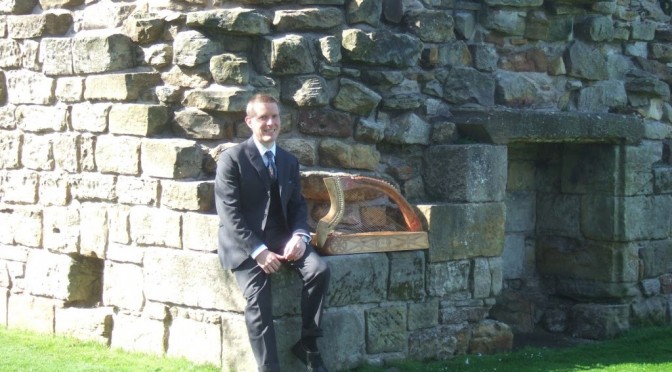 Tristan being sent into exile, from a medieval German woodcut
Tristan being sent into exile, from a medieval German woodcut
On Tuesday 7th September at 12.45pm, early harp specialist Simon Chadwick will be playing historical Scottish and Irish music in the ruins of St Andrews Cathedral.
Using his decorated replica of the medieval Scottish ‘Queen Mary’ harp with gold and silver wire strings, Simon will play a selection of music associated with ancient Scottish, Irish and British heroes.
Starting with a medieval composition said to have been performed before King Arthur and his Knights as they sat at the Round Table, the programme will look at the medieval Gaelic legends of Fionn and Oisean, before finishing with a heartbreaking lament for the forlorn Cornish lover, Tristan.
This event is the last in Simon’s summer series of medieval harp concerts in the cathedral. Performed in the Priors House, a medieval vaulted chamber set within the ruins of the Cathedral in St Andrews, this series brings to life different aspects of ancient and historical Scottish music, from the medieval church, to stirring battle marches, to weeping Gaelic laments.
The harp Simon uses is a unique replica of the clarsach of Mary Queen of Scots. The 500-year-old original is preserved in a glass case in the National Museum in Edinburgh, as featured on the BBC’s “Reporting Scotland” last month, with Simon providing musical accompaniment! Simon commissioned his replica from Irish harp maker Davy Patton in 2006-7. With its amazing soundbox carved out of a single huge willow log, and its intricate carved and painted decoration, the replica harp is a precious medieval art object that fits very well into the ancient ambience of the cathedral.
Admission is free. Tickets can be reserved in advance by calling the Cathedral visitor centre on 01334 472563.
A preview of this event will be performed in the Wighton Centre, Dundee Central Library, Dundee, DD1 1DB, Wednesday 1st September, 1.15pm.







